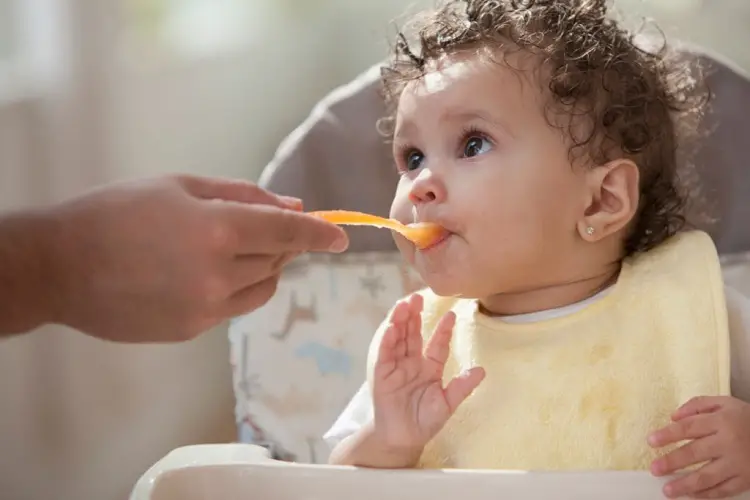As a new parent, your utmost concerns almost always revolve around your little ones for the first year of their birth.
During this period, certain questions like how much Gerber should a baby eat, and other types of healthy solid foods to feed them may come to mind.
However, you may want to feed your baby solid foods to ensure he eats well; knowing how much is not too much or too little brings about questions like how much Gerber a baby should eat in one sitting or a day.
Gerber Baby Food: What does it mean?
Gerber, the world’s largest producer of baby foods, is a known brand in the baby food industry.
Aside from baby food, Gerber also makes breastfeeding supplies like manual massaging pumps, nipples, and baby feeding bottles. They are a subsidiary of Nestle, and their products are generally accepted nationwide.
How Much Gerber Should a Baby Eat?
When babies begin eating solid foods, they fall within the age brackets of 5 to 6 months; some begin at a much earlier age, like 3 months.
However, the quantity of solid food they can consume during this period may not necessarily mean any health implications since the foods are still complimented by breast milk anyway.
So if you’ve introduced your baby to solid food and they don’t seem to be eating it as much as they drank breast milk, it is not something to be worried about yet.
Chances are that your baby is probably still trying to adjust to the new taste he feels in his mouth, and with time, he may come to enjoy it better.
Most babies between the ages of 4 to 6 months can eat about 3 to 4 tablespoons of cereal in one feeding once or twice a day, one fruit or vegetable 1 or 2 times a day.
Babies above six months (between ages of 7 to 9) can eat 4 to 5 tablespoons of cereal 1 or 2 times a day and 1 or 2 fruits or vegetables 1 or 2 times a day. Some may be able to eat protein foods like boiled eggs or meat once a day.
Read Also: Gerber vs Cerelac – Features, Pros & Cons
Signs That Baby is Ready to Eat Gerber
It may feel as though you just welcomed your little one, and right one, he is ready to start eating solid foods. As first-time parents, seeing your baby explore new foods with you can be quite exciting.
Here are some signs to look out for to know if your baby is ready to start eating Gerber.
- If your baby can hold his/her head up and turn smoothly from side to side, then your baby is ready to start eating solid foods. Babies need good head and neck control while eating, which usually happens between the ages of 4-6 months.
- If your baby seems interested in food, he/she is ready to start Gerber.
- Does your baby grab your spoon/fork or seem eager to have a bite each time you want to eat next to them? If yes, then your baby is ready for solid food.
- If your baby swallows any food given to him, he’s ready to try something new. Babies are born with natural reflexes that help them push food out of their mouths as soon as they put it in. As time goes on, they lose this reflex usually by the time they clock 4-6 months, making it easier for them to start solid foods like Gerber.
- If your baby often reaches out for food or opens his mouth each time food approaches, he is ready to start Gerber food.
- If your baby can sit properly on a chair, then you can begin introducing solid food to him.
- If your baby’s current weight is twice that he weighed during delivery, you can begin introducing solid foods like Gerber.
How Often Should You Feed Your Baby Gerber?
If you change your baby’s diaper frequently due to peeing and pooping and he shows signs of being satisfied when fed, this is a sign that your baby is getting enough food, and you should keep up with the regular feeding pattern.
Feeding your baby 3 to 4 hours of solid foods is recommended. Although he may not always consume the same amount of food, if you pay attention to his feeding pattern, you will know when he is satisfied or not in order not to overfeed him.
Read Also: How To Thicken Breast Milk With Oatmeal
How to Transition Your Baby into Solid Foods

Many babies within the age brackets of 6 months upward begin to exhibit signals that they’re ready for solid foods.
You can start gradually by introducing a few bites of some solid foods that are not too hard for them to swallow.
Intercept your usual breast milk time with a few spoons of solid foods and begin to increase the intake once you notice that their appetite has peaked on the solid foods you introduced. You can start with a few spoons of cereal or very soft pasta.
Feeding Formula guide for babies below 6 months
- 0-1 month: 2 to 4 ounces of milk 6 to 8 times a day
- 2-3 months: 5 to 6 ounces of milk 5 to 6 times a day
- 4-5 months: 6 to 7 ounces of milk 5 to 6 times a day
Should You Be Worried If Your Baby’s Appetite Fell After Weaning?
Your baby drank a lot of milk before weaning, but a loss in appetite after being introduced to solid foods should not be a cause for alarm.
As babies grow, their feeding pattern changes along with how much they can consume at a time. Depending on age, many drink breast milk an average of 8 to 12 ounces between 4 to 5 hours a day.
But after they have been weaned off and are introduced to solid foods, their pattern of feeding changes. Some tend to eat less for the first few weeks of tasting solid foods but prefer it over breast milk.
Read Also: Formulas That Taste Closest To Breast Milk
Other FAQ’s
Are Gerber Foods Healthy?
Yes, Gerber foods are 100% safe and nutritious for your baby. They meet FDA standards and requirements as they follow strict rules when producing baby foods.
Why Did Your Baby’s Poop Change?
A change in diet can cause your baby’s poop to change in appearance, weight, and even smell. This is not a bad thing; it is only an indication that there is an alternation in what he eats.
When you intercept the usual breast milk your baby is used to consuming with other solid foods like fruits, vegetables, cereals, or pasta, the result would be a heavier, darker, and smellier diaper. And this is very healthy.
What Are The Suitable Foods For Babies During Weaning?
Fruits or vegetables: people hardly get it wrong with this duo. A few slices of some fruits or vegetables for your baby to eat during the weaning stage.
Bread and pasta: A very soft bread and well-cooked pasta will not be a bad idea to get your baby distracted from the breast milk.
Cheese and meat or poultry: The first bite into cheese almost registers no particular taste. It is just very soft and easy to bite into. Also, well-cooked meat or chicken will be okay.
What Foods Should I Avoid During Baby First Year?
Just as it is important to know when to introduce certain foods, it is also important to know which foods to avoid.
Before your baby clocks one year old, you should avoid the following foods grapes, hot dogs, cow’s milk, fruit juice, honey (botulism risk), raw or uncooked eggs, meat or fish, and unpasteurized cheeses.
Read Also:
- What To Eat When Breastfeeding Sick Baby
- Best Formula To Keep Baby Fuller Longer
- How Much Pedialyte For 1 Year Old
Conclusion
After introducing solid foods into your baby’s diet, the question of how much Gerber should a baby eat is likely to cross your mind one or two times.
You are mindful not to do too much or too little, which is normal for first-time parents. But as much as it is a matter of concern, it should not cause you to beat yourself up about questions that can easily be answered, which this article has already done.
The most important thing is to pay attention to your baby’s cues during feeding. Know when he is satisfied with the food or not and stick to his pattern in order not to overfeed him.
You may want his appetite to improve so severely, but a little patience will do since he is just getting familiar with these solid foods.
